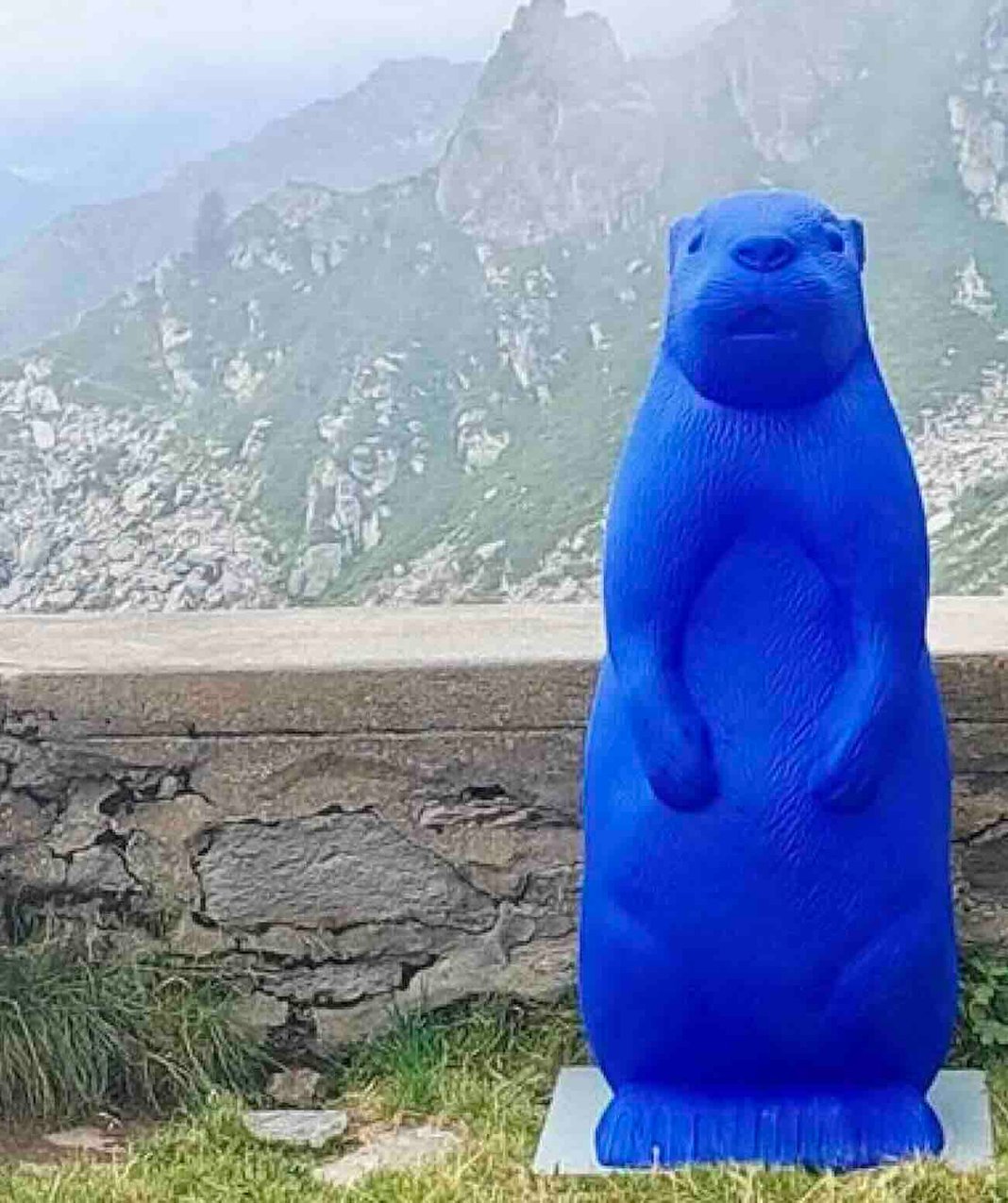The news in brief
- Le colorful marmots in the mountains, works of Cracking Art, intend to stimulate emotion and empathy, using regenerated plastic.
- The works symbolize a new alliance between man and nature, promoting sustainability and responsibility, in an era of climate changes.
Bologna – In the mountains, marmots are often spotted on trails: they make themselves known by their whistle, sounding the alarm of intruders in their territory. Then, by squinting or perhaps with binoculars, you can spot them from afar near their burrows.
But for a few days now, between Piedmont and the Aosta Valley, some very, very visible marmots have emerged: they're large, brightly colored, and they stand just steps from some shelters. You can admire them up close: they're truly works of art.
Cracking Art created them (23 examples) in collaboration with the Efisio Noussan Museum of Natural Sciences of the Aosta Valley: 25 metres tall and with vivid colours, “because the aim is not to create copies of nature but to create a fantastic bestiary that is representative of our time, favouring shapes and colours that give emotion and stimulate empathy”, explain Cracking Art.
And some have even considered bringing them to the mountain huts: Coda and Rivetti in the Biella area, and Quintino Sella and Vittorio Sella in the Aosta Valley. But not everyone liked them: it's plastic invading the mountains, some have objected.
The marmots are made of recycled plastic
The controversy surprised the president of the Biella Italian Alpine Club, Andrea Formagnana: not so much because of the differing opinions—"discussion is welcome"—but because of "the superficiality of certain criticisms. Some have talked about discarded plastic, others have brought up the 'contamination' of the mountains…
I'd like to clarify once and for all: we're not leaving waste at the summit. The Cracking Art works are made from recycled plastic, placed only in the immediate vicinity of the refuges—areas already populated—or inside them. And above all, they're part of a circular economy: when they deteriorate, they're remelted (brought down to the valley, ed.) and given life to new works. Nothing is wasted.
An old legend
The idea of bringing the colorful marmots to the mountains "was born from an extraordinary discovery: in 2024, a marmot preserved for over 6.000 years emerged from the Lyskamm glacier (Monte Rosa). A creature from another time that seems to want to tell us something today.
At that moment, I thought: what if she were a time traveler? An ally come to remind us of the urgency of addressing climate change?” Formagnana explains. “The suggestion of the marmot,” he continues, “brought to mind the legend of the Kingdom of Fanes, one of the founding myths of the Ladin people. It tells of an ancient Alpine people in alliance with marmots, a symbol of humility and sociability.
When the Fanes betrayed that alliance to follow an arrogant king, they met ruin. But the marmots saved the survivors, hiding them in their burrows. Even today, it is said that on the night of the summer solstice, the Queen of Fanes awaits the return of peace on a boat.
It's a story of a broken alliance that needs to be rebuilt, just as we need to rebuild our relationship with nature today." And so Formagnana wanted to try a "new language to talk about these issues. And Cracking Art, with its colorful, ironic yet profoundly meaningful animals, is perfect. Then, coincidentally, they too had been inspired by the discovery of the Lyskamm and had created the marmots."
A few months ago, there was "a beautiful installation at the Château de Saint Pierre." From there, a collaboration was born to bring the 'marmot of time' to the refuges, as part of the "Soul of the Mountain" project, an initiative that combines culture, environment, music, and Alpine spirituality.
Here they are at the Coda and Rivetti refuges in the Biella area, and at the Vittorio Sella and Quintino Sella in the Aosta Valley. "And with the young talents of the Oropa Music Festival, we bring great classical music." Moreover, the Biella refuge in the Dolomites is located in the very valley where, according to legend, the Kingdom of Fanes was born. "It's as if an invisible thread unites everything: history, the mountains, the marmots, our present."
The groundhog as a symbol of hope
What do you say to those who say that this way the mountain is being “denatured”?
That the European mountains, as we know them, are the fruit of an ancient alliance between man and nature. The pastures, the terraces, the cultivated forests: all of this is the work of man. True wilderness exists only at glacial altitudes.
Today, more than ever, the mountains need humanity: to prevent fires, manage slopes, maintain biodiversity. And humanity needs the mountains: for water, air, silence. The Cracking Art marmots represent this new alliance, this new awareness,” replies Formagnana.
And then, "the works speak of rebirth, collaboration, and sustainability. The groundhog emerges from hibernation with spring: it's a symbol of hope. It lives in a colony: it teaches us the strength of community. And the figure of the 'sentinel'—the one who watches over the group—is our image of responsibility.
Here, we would like everyone to feel a little like mountain sentinels." And as for the criticisms about the use of plastic, Cracking Art "was born precisely to reflect on the paradox of plastic" and "regenerating plastic to make art means removing pollution and transforming it into a message.
The works themselves enter a virtuous cycle: when they deteriorate, they are remelted and remade, in a perfect example of the circular economy. And then, let's face it: plastic, if used well, has revolutionized medicine, hygiene, and food preservation. It's not about demonizing it, but learning to use it intelligently. And we have done just that.
More attention to sustainability
Furthermore, the president of the Biella CAI (Italian Alpine Club) points out that plastic is in "the technical clothing we wear in the mountains: some, when washed, release micro- or nanoplastics that end up in rivers and the food chain. More attention and environmental awareness are needed."
And alternatives exist: in the Biella area, for example, there are pioneering companies that make high-performance technical clothing using wool and natural fibers, while respecting the environment. Awareness is also exercised in small gestures: when we shop, when we choose what to wear, when we decide how and where to shop. Sustainability begins in our everyday lives.
Finally, why put a colorful marmot next to the bust of Quintino Sella? "Because even Quintino, founder of the Italian Alpine Club, knew how to look far ahead. In a letter to his fellow senators, he wrote of the importance of bringing the telegraph even to the most remote mountain villages.
He believed in humanity's ability to use intelligence to find solutions, correct mistakes, and cope with challenges. That's why I wanted that photo: the Cracking Art marmot and Sella's bust, facing each other. As if to say: the future is also built like this, with imagination, science, culture, and respect." Postscript: the marmots cost the Biella Italian Alpine Club nothing, "thanks to the generous support of the Cracking Art collective." "A marmot won't save the world. But perhaps it will help us remember that it's time to change pace," concludes Formagnana.
Article published by the editorial staff on July 24, 2025 - 16:24 PM
We are the editorial staff of Cronache della Campania. It may seem like an abstract account, but we can assure you that these articles are always written by a human—in fact, more than one, which is why we use this account. To learn more about our editorial staff, visit the "Editorial Staff" page above in the menu, or at the bottom. Enjoy!











